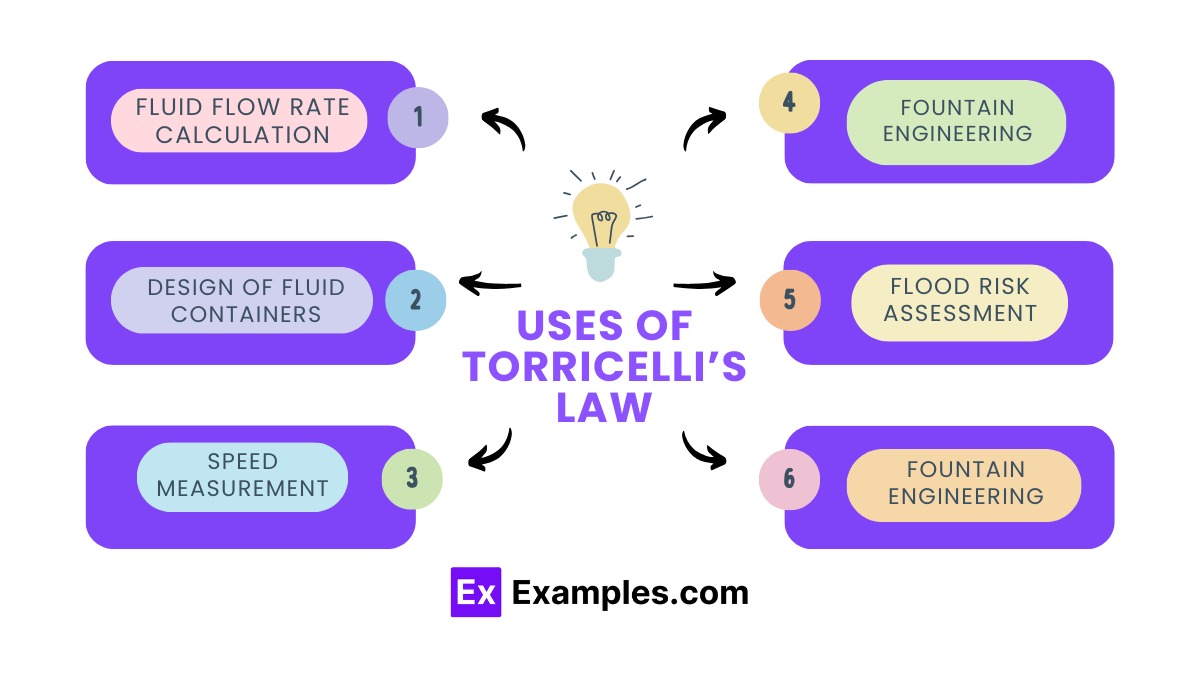What does Torricelli's Law describe?
The speed of fluid flowing out of an orifice
The pressure in a closed container
The density of a fluid
The temperature of a gas


Torricelli’s Law in physics describes the speed of fluid flowing out of an orifice or opening due to gravity. This law, derived from the principles of fluid dynamics, states that the speed (𝑣) of efflux of a fluid under the influence of gravity
The formula for Torricelli’s Law is:
where:
This formula demonstrates that the speed of the fluid flow depends on the square root of the product of twice the gravitational acceleration and the height of the fluid above the opening.
To understand the derivation of Torricelli’s Law in a simpler way, let’s follow these steps:
Imagine a container with a small hole near its bottom filled with water. The water flows out of this hole, and we’re interested in finding out how fast it flows.
We use the concept of potential and kinetic energy to derive the speed. At the water surface (top of the tank), the water has potential energy because of its height above the hole.
According to the law of conservation of energy, the total energy remains constant. As water falls towards the hole, its potential energy converts to kinetic energy, increasing its speed.
Assume the surface of the water is much larger than the hole, so the speed of water at the surface is negligible. Assume the pressure of the water is equal at the surface and at the hole, as they are both exposed to the atmosphere.
Since potential energy (𝑃𝐸) converts to kinetic energy (𝐾𝐸): 𝑃𝐸=𝐾𝐸 𝑚𝑔ℎ=1/2𝑚𝑣²
Canceling mass 𝑚 on both sides: 𝑔ℎ=1/2𝑣²
Multiply both sides by 2 to isolate 𝑣²:2𝑔ℎ=𝑣² Take the square root of both sides to solve for 𝑣: 𝑣=√2𝑔ℎ This is Torricelli’s Law, showing that the speed of water flowing out of a hole depends on the height of the water above the hole.

Torricelli’s experiment, commonly taught in Class 11, demonstrates fluid pressure principles. By creating a vacuum with mercury, it shows how atmospheric pressure influences fluid columns in tubes.
In Torricelli’s Law, efflux refers to the fluid flowing out of an orifice due to gravity. Therefore, its speed depends on the height of the fluid above the opening.
To demonstrate atmospheric pressure, Torricelli filled a tube with mercury, inverted it into a dish, and observed the mercury column. The resulting height represented atmospheric pressure.
Text prompt
Add Tone
10 Examples of Public speaking
20 Examples of Gas lighting
What does Torricelli's Law describe?
The speed of fluid flowing out of an orifice
The pressure in a closed container
The density of a fluid
The temperature of a gas
According to Torricelli's Law, what is the formula for the speed of fluid exiting an orifice?
v = √(2gh)
v = gh
v = g/h
v = 2gh
In Torricelli's Law, what does the variable 'h' represent?
Pressure of the fluid
Density of the fluid
Height of the fluid above the orifice
Volume of the fluid
What physical principle is Torricelli's Law derived from?
Bernoulli's Principle
Pascal's Principle
Archimedes' Principle
Newton's Second Law
How does the speed of fluid exiting an orifice change if the height of the fluid column is quadrupled?
It halves
It quadruples
It doubles
It remains the same
What is the primary assumption made in Torricelli's Law?
The fluid is compressible
The fluid flow is non-viscous and steady
The fluid temperature is constant
The orifice is very large
Which of the following units is used for the height (h) in Torricelli's formula v = √(2gh)?
Meters per second (m/s)
Kilograms (kg)
Meters (m)
Newtons (N)
If the height of the fluid column is 10 meters, what is the speed of fluid exiting the orifice? (Use g = 9.8 m/s²)
10 m/s
14 m/s
20 m/s
30 m/s
How does the speed of fluid change if the gravitational acceleration (g) is doubled?
It remains the same
It doubles
It increases by a factor of √2
It halves
Which parameter is not involved in Torricelli's Law?
Height of the fluid column
Gravitational acceleration
Density of the fluid
Speed of the fluid
Before you leave, take our quick quiz to enhance your learning!

